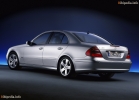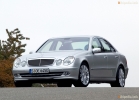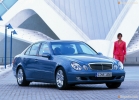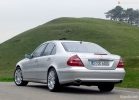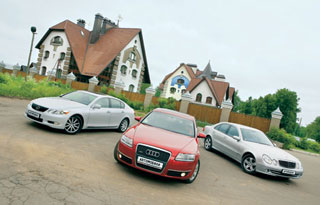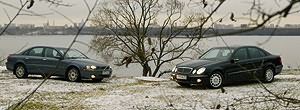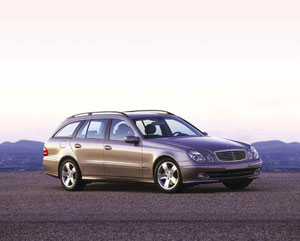Test drive Mercedes Benz E-class w211 2002-2006 sedan
In a personal meeting
We are already used to the eye machines. Back in 1995, the serial Mercedes-Benz E-Class debuted, which laid the foundation for the ophthalmic direction in automobile design recall Jaguar, Lexus and a number of other brands.The machine opens with a characteristic wedge -shaped key. It is supposed to be inserted into the nest, and then put it in a pocket. This version is launched by the Start Stop button, located on the transmission selector's knob. If a person without a key in his pocket sits behind the wheel of an already started car, you are not identified in the center of the speedometer.
Such devotion amuses the owner’s pride, but also alarms: the vigilance of the owner of the car is dull, and for the hijacker a working motor half of the case. But the idea to place an additional information display in the free space of the speedometer is impeccable: the tire pressure, air temperature, navigation and a number of other data can be displayed here. For the first time, this solution was applied to S-Class.
By the way, the parallels with the flagship of the brand do not surprise the interior was created under the guidance of Hans-Diter Fuchik, who headed work on the arrangement of S-Class.
In the housing of the salon mirror, the holes of the microphones of the built -in system of satellite communication Bluetuth are visible. The number can be dial with the buttons on the steering wheel. Digital signal processing allows you to better hear it in the midst of road noise. On the central console there is an on -board information terminal Audio 50 APS, compatible with the Linquatronic voice control system; If you speak English, quite legibly dial the number from the voice!
The contrast against the background of innovations are decisions that have long been present on Stuttgart cars. In the previous places there were a toggle switch for the closest light (although in the dark the headlights light up automatically), a parking brake pedal (though with a hand -licketer) and the seat settings arranged in the form of a tiny armchair.
But this was not there before: another setting knot near the right corner of the driver's seat. The device controls the position of the side rollers and the lumbar support of the front seats. They are built -in fans and fur (in the front of the pillow, in the lumbar zone and on each side of the back), which automatically inflate, supporting the body with lateral accelerations.
Mercedes-Benz strictly withstands its respectability. If the upper part of the rim of the steering wheel is wooden (and even with warming up), it means that they will not expect you to hold on to the steering wheel with a sports grip. For the incomprehensible, confusing e-class with Subaru, and the turn indicators lever are placed so that it is convenient to use only if you hold the wheel from below. In general, the concentration of levers to the left of the steering wheel is slightly annoyed: cruise control, accidentally turned on on a mountain serpentine, can bring to trouble.
The steering is trampled. Zero steering is felt perfectly, but the reactions are soft, and the return action is completely absent. You enjoy on a highway, you begin to worry on a winding road and completely mobilize in the city when, with a turn, you have to forcefully return the steering wheel to its original position. You have to get used to it.
The overview from the cabin is excellent. Special thanks for the sculptural forms of the hood. According to his distinctly readable edge, it is very easy to navigate. In difficult cases, the Parktronic system will come to the rescue that the obstacle remains dangerous to the obstacle. (True, our first attempt to check the system failed: the red LEDs on the front panel did not light up, the warning picked did not come. promotion of the brand.)
The lineup consists so far of five modifications: E240, E320, E500, E220 CDI and E270 CDI. All of them are offered in the already traditional performances of CLASSIC, Elegance and Avantgarde (it is easy to recognize it by the front bumper smiling to the ears). In addition, there are 15 body painting options and 4 interior decorations.
Serially, a 6-speed manual gearbox or a 5-speed machine with the Lock-UP function (turning on the mechanical locking of the hydrotransformer) is installed on machines in the first gear, which allows you to start more energetically. You can also order the transmission of Sequentronic, although the benefit of its presence in a car of this class is doubtful. Forced nod control of the SEQUENTRONIC lever is not much different from the sequential switching mode, into which the traditional automaton is translated. When driving in automatic mode (SEQUENTRONIC allows this) is too tangible to delay and jerking at the time of transition to the next gear. We also note that with a car price from 45 thousand euros, the winnings on the installation of a tonik look insignificant.
The E500 modification is standard (all the rest by order) is equipped with an advanced Airmatic DC pneumatic suspension, first used at the end of 1998 on S-Class. It perfectly practices irregularities, retains the position of the body in corners, does not allow a loaded car to squat.
For the front bridge, Mercedes Technology Center chose a four -winging scheme with a counter. This design provides more accurate kinematics and the best absorption of impact energy in a frontal collision than a two -legged one.
The back suspension is made according to the beloved Mercedes multi -link scheme. Here the pneumoballon is located separately from the shock absorber for the sake of compactness.
The elasticity of pneumo elements and the rigidity of shock absorbers are regulated by the microprocessor individually for each wheel. Using keys near the transmission handle, the driver can dissolve or clamp shock absorbers or even increase the clearance of the car to overcome the uneven section of the road. For greater stability when driving at a speed of more than 140 km/h of the body, on the contrary, drops by 15 mm.
E-classic materials are widely used in E-Class. Ten percent of the mass of the machine falls on aluminum (hood, front wings, pendants, subframes, frames of the front and rear parts of the body, etc.). Power jumper under the front panel of the cabin, the bracket of the steering column and the frame of the steering wheel is magnesium. Part of the aluminum lid of the trunk is plastic. Below the body is also protected by eleven plastic panels that at the same time improve the streamlines of the machine.
Aerodynamics is a special topic. In the previous e-Class, the coefficient of the circuit was 0.27, and now 0.26. That's where they cut out on trifles! For example, miniature spoilers were installed in the arches in front of each wheel, reducing air anti -pressure that occurs in front of the bus. On modifications of the E240 and E320, the air intake in the front bumper is equipped with a 16th shutters with an electro-pneumatic drive, which at high speeds reduce the air resistance by 3%. However, their main purpose is to optimize the cooling of the motor. The microprocessor analyzes the speed of the car, the temperature of the coolant and the operation of the air conditioner, after which it opens the shutters exactly so much as not to create unnecessary air turbulence.
The top of the lineup of the elegant road cruiser E500, whose 17-inch discs are shod in low-profile sports tires Pirelli P-zero. With the V8 engine from the S-CLASS, the car powerfully takes from the place, and then accelerates measuredly, but energetically. In the cabin, quiet, as in the captain’s cabin. However, when the kikdown is turned on, a characteristic cooing of the hydrrotransformer penetrates here and shocks are transmitted from the suspension driven into the sports regime. And correctly, the captain must know what is happening on the ship.
The role of a poor relative in the family is assigned to the E220 CDI version. And in the rubber he was shoeing inexpensive, and the salon was equipped at a minimum. Thus, the longitudinal movement of the front seat is regulated by a familiar poker since the 70s, and the four-zone climate installation of Thermotronic (creating individual weather for passengers) is replaced by the Thermatic more modest system. That is why E220 CDI grumbles offended, and accelerates reluctantly, and creaks upholstery.
At a press conference, someone asked a question about a taxi modification. So she is! It is unlikely that a four-cylinder 2.2-liter diesel engine will attract someone's special attention.
However, this 150-horsepower small is not devoid of advantages: direct injection, nozzles with seven nozzles (before there were six), a fuel ramp with pressure already 1600, and not 1350 bar, a double pilot injection, a turbocharged with a variable geometry. There are two balancing roller Lanchester, which extinguish vibration. It is amazing that they had to install them at all: a new generation of CDI engines is already distinguished by small vibrations and reduced noise. The taxi will be launched into the series for six months.
Testing and all-wheel drive E-Class. The design of his body and chassis was undergoing minimal alteration, mainly the front subframe will be affected. The traditional partner in the development of Viermatic is the Austrian company Steyr-Puch. Well, then, apparently, T-Modell wagon should be waiting.
The main technical advantage of the new E-Class brakes of the Sensotronic Brake Control (SBC) system, in which there is no hydraulic connection between brake cylinders and pedal. This completely eliminates its beat when stabilization systems are triggered. In addition to adequate, predicted slowdown, the brakes create a sensation of considerable reserve in the driver. They also have a SoftStop function that helps avoid clicks with sloppy work with a pedal, which often happens in traffic jams. Finally, automatically drying the brakes at the command of the rain sensor.
The cost of sophisticated electronics of the new Mercedes-Benz is almost half the price of the entire car. On the one hand, these systems significantly increase comfort and safety (the same SBC holds the machine from demolition in a steep turn, brakes of external wheels, even before the ESP entered the operation of the defense here). On the other hand, any electronics has a speed limit, and if it is exceeded, nothing will stop the car. The approach of this threshold is almost not felt in the control of the car manifests itself neutrally, the turns are passing with minimal rolls even with loose shock absorbers. Involuntarily, you become infected with his confidence.
However, from whom, if not from Mercedes-Benz masters, to wait for such innovations. Stuttgart does not often change the model, but each time it represents a finished masterpiece. They will be admired, of course they will argue about him. But this is precisely what happens with any outstanding creation of human hands.
Text: Denis Orlov
Source: Magazine 5 wheel [04/2002]
Video test drives Mercedes Benz E-class w211 2002-2006
Video crash tests Mercedes Benz E-class w211 2002-2006
Test drives Mercedes Benz E-class w211 2002-2006
Crash Test Mercedes Benz E-class w211 2002-2006
Krassh Test: Detailed Information33%
Driver and passengers
4%
Pedestrians
Mercedes Benz E -class w211 2002 - 2006
Mercedes Benz E-Class: Detailed Information| E -class w211 2002 - 2006 | |
|---|---|
| Engine |  |
| Transmission |  |
| Control system and suspension |  |
| Brake system |  |
| Air heating and air conditioning |  |
| Launch and charging system |  |
| Electric components and so on |  |
| Corrosion body stability |

